Kathleen Flinn's Blog, page 5
February 2, 2023
Recipe: Spicy Turkish Chicken Wings with Chili-Oregano Salt

I have a thing for chicken wings. Yes, I might be a French-trained chef and I have the ability to make complicate sauces and all that. But I love chicken wings. Hot wings, savory wings, smoked wings, you name it. They’re a great vehicle for virtually any flavor profile.
So when I was going to sit down with food journalist Robyn Eckhardt for the remarkable book Instanbul and Beyond: Exploring the Diverse Cuisines of Turkey and I saw she had a recipe for wings, I thought, “Done. That’s the first recipe I’m going to try.” We ate them as part of the conversation we had for my podcast, Hungry for Words. You can listen here.
This is her version of the not-too-spicy savory chicken wings found on huge rotisseries throughout Istanbul’s famed Tahtakale Market, Istanbul’s famed spice bazaar. Even a modest stalls may sell hundreds of pounds of wings a day. She notes the wings are generally accompanied by a few traditional sides: grilled green chiles, sliced onions and tomatoes along with a bulgur pilaf and dimpled flatbreads. The wings are first tenderized in a bath of vinegar and onion, then coated in a seasoned olive oil. Having made these several times now, there are two keys: the vinegar/onion marinade and the accompanying salt.
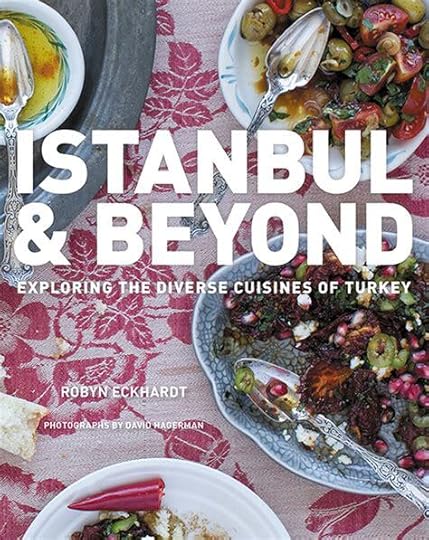
Click the cover to listen to my chat with Robyn
The recipe calls for Aleppo chili pepper which can be tricky to find. I get mine from World Spice in Seattle. You can substitute red pepper flakes. I prefer using oregano to thyme or a blend of the two in this recipe.
She recommends against barbecuing these and I agree; a hot oven will best mimic the rotisserie flavor. These are best cooked on a large cooking sheet fitted with a cooling rack. If you don’t have one, a broiler pan works fine. Neither? A plain cookie sheet works, just turn them regularly while cooking. I admit, we usually just eat the wings alone, but you can make a meat of them if you serve with some flatbread, a savory grain and sliced onions, tomatoes and cucumber. They reheat fabulously.
PrintTurkish Market Chicken Wings with Chili-Thyme SaltAddictive spicy and savory wings from Istanbul's famed spice market.Course AppetizerCuisine MediterraneanKeyword chicken, Easy, picnic fare, spicy, take to a party, Turkish, wingsServings 4Author Robyn EckhardtEquipmentTongsBaking sheetCooling rackIngredientsTenderizing marinade16 chicken wings (about 2 lbs/1 kilo)1 medium onion1 cup apple cider1 teaspoon sea saltSeasoning marinade3 tablespoons olive oil1 teaspoon Aleppo pepper or dried red pepper flakes3/4 teaspoon ground cumin1 teaspoon dried thyme or oregano½ teaspoon sea saltHerb-Chili Salt1 tablespoon dried thyme or oregano 1 tablespoon Aleppo pepper or red pepper flakes½ teaspoon coarse saltInstructionsTenderizing marinadeGratethe onion or pulse in a food processor. In a large bowl, combine with thevinegar and salt and stir to combine. Add the wings and toss to coat. Cover thebowl and marinate overnight or for at least four hours, jostling the wings fromtime to time. To save space in your fridge, you can transfer to a well-sealedplastic bag. Seasoning marinadeCombinethe olive oil, chili flakes, cumin, thyme or oregano and sea salt in a largebowl. Remove the wings from the tenderizing marinade, pat dry with paper towelsand add to the bowl. Stir or toss with tongs until the wings are coated withthe new marinade. Cover and refrigerate for at least an hour or up to fourhours. Herb-Chili SaltIna small bowl, mix the red pepper and the thyme or oregano. Stir in the salt.Set aside.Roast the wingsPreheat the oven to 450*F/TKC. Line a baking sheet with foiland top with a oiled cooling rack, or line a broiler pan with foil. Remove thewings from the marinade and roast for about 10 minutes. Using tongs, turn andcook an additional 10 to 15 minutes until well browned and cook through. Servehot with the chile-herb salt.The post Recipe: Spicy Turkish Chicken Wings with Chili-Oregano Salt appeared first on Kathleen Flinn.
January 1, 2023
Eat Better and Waste Less Food in 2023

I have one word to sum up the past few years – Kuchisabishii. It’s Japanese for “eating when you’re not hungry but you eat because your mouth is lonely.” My mouth would get so lonely starting in March 2020 so often that I gained 20 pounds of pandemic weight.
Is there a word for cooking when your heart is lonely?
Our kitchen, so often bustling with cooking classes, brunches, lunches or dinner parties, only partially revived last year. We’re lucky to be able to spend loads of time with my beautiful mother in Florida; I am profoundly grateful. Mike and I rang in 2022 with mom, toasting with Veuve Clicquot at midnight while watching Betty White’s skits on SNL. (RIP Betty. I will always love you.) This year for the first time since 2019, we invited friends to get together at our house on Anna Maria Island. We feasted on tenderloin from the grill and toasted guests who ranged from seven to 62.
This past year was better for us as a society, but tough for me personally. I was diagnosed with a toxic and potentially fatal bacterial infection in my gut. I ended up on antibiotics for nearly seven months. Meanwhile, to try to heal my gut, I had to (mostly) give up drinking coffee, alcohol, sugar and overhauling my diet. Starting in September, I was able to start eating more normally, but I learned a lot about rebuilding my microbiome, the subject of my next non-fiction book. As a result, I’ve been spending a lot of time and energy thinking about how to eat healthier, particularly adding in good things for your microbiome. I’ve been quietly updating pages throughout the site. I’ll be posting more about this in the coming weeks. I will also be (finally!) launching online cooking classes in February.
Do your resolutions include eating better?So, let’s start with the cooking and teaching part. If you’ve made resolutions that involve improving your diet, losing weight, etc. here’s something for you. Below are links to a few video lessons and primers that may be helpful to you if your resolutions include cooking more, eating better and saving money — all are good things to aim for, right?
 Knife Skills
Knife Skills How to Make Vinaigrette
How to Make Vinaigrette How to Make Vegetable Stock
How to Make Vegetable Stock How to Cook in Parchment
How to Cook in Parchment A Cheat Sheet to Flavor Profiles
A Cheat Sheet to Flavor Profiles Quick Guide to Herbs & Spices
Quick Guide to Herbs & Spices Basics of Soup Making
Basics of Soup Making
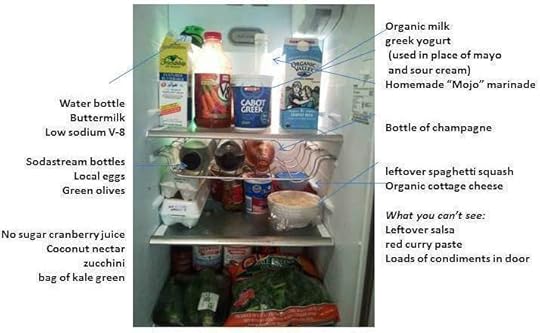
Here’s a New Year’s resolution for you
Start the year by knowing what’s actually lurking in your kitchen. Take everything out of each and every one of your cupboards, your fridge and freezer. Clear out expired stuff, junk food and the stuff you’ll just never use. In your fridge, post a photo of your favorite thing – your children, your husband, your dog, whatever. Make a point to never fill your fridge so stuffed that you can’t see it. Research shows that an emptier fridge leads to weight loss. “Eat down” your fridge, shop more often. More on this process.

If you want to eat better but not spend more, here’s a simple tactic: waste less food. The average American household wastes about 30% of all the food they purchase. No one would throw a $5 bill in the trash, but if you toss that lovely bunch of organic beets, it’s the same thing.
A couple of tips: when you bring home your produce, get out some post-it notes. Write down the price of that broccoli ($3) and put it right on the broccoli or the bag holding it. Do the same for all your fruit, vegetables, dairy or anything perishable. Then, when you go to throw out that item, collect that post-it with the others. Do this for a month. How much did you waste?
To learn more about the impact of food waste, I highly recommend the book Wasted Food by Jonathan Bloom.
Bad cooks welcome! To join my league of recipe testers, send me an email and I’ll send you the “secret” page for my Fearless Friends, and the password.
I post new recipes regularly, and ask testers to simply fill out surveys afterward. I sometimes get in touch to ask you more questions. I give away gifts and get to know my testers, so don’t be shy!
[image error]The post Eat Better and Waste Less Food in 2023 appeared first on Kathleen Flinn.
December 4, 2022
Recipe: Easy Peppermint Bark
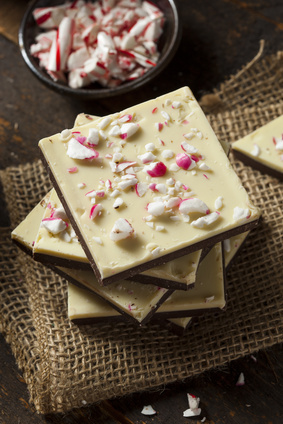 There’s a reason why I love peppermint bark that begins with a confession: I don’t like chocolate.
There’s a reason why I love peppermint bark that begins with a confession: I don’t like chocolate.
I don’t loathe it, I just don’t love it. This news always takes people by surprise. Somehow by the mere fact of my gender, it’s assumed that I must immediately be in love with all things dark and sweet. But taste is so highly individualized and pesky in nature. Give me a choice between a wedge chocolate cake and a slice of banana cream pie, you’ll find the banana-soaked remains of a crust within seconds.
By contrast, I once had a quart of chunky double chocolate ice cream in my fridge for two years until a friend house-sitting at my place after a break-up with her boyfriend ate the whole thing in one sitting.
This proved an issue when I worked as a restaurant reviewer. When I first wrote reviews, I often skipped dessert. After all, I’m not a dessert person. But then I was working with Tom Sietsema, now the reviewer for The Washington Post. He said, “Kat, dessert is the reason why some people have to go out. You must put your personal preferences aside for the sake of your readers.” So I plowed through endless cakes, creme brulees and died what felt like a thousand deaths by chocolate.
My sister’s peppermint barkThroughout the years, I’ve fallen in love one thing that’s decidedly chocolate based: my sister Sandy’s peppermint bark. Part dark chocolate, part white and topped with crushed candy canes, it somehow defeats my anti-chocolate bias.
Peppermint bark is easy to make. It requires no baking prowess other than the ability to patiently melt chocolate chips. Wrapped up in a nice container, it’s makes a lovely holiday gift, too. My sister used to spend a full weekend day making pounds of it to give to her magazine staff around the holidays. She packed it into tidy, colorful boxes along with personalized cheery notes. While she was at it, she’d made some for the family, too.
She’s semi-retired now and no longer works in an office, so she doesn’t do the marathon bark making anymore. So if I want peppermint bark these days, I have to make it myself. I turn on some cheery holiday music, grab the bags of dark and white chocolate chips, crush up some candy canes and be merry.
 PrintRecipe: Easy Peppermint BarkThis is my sister Sandy's recipe. You'll need parchment paper to make the recipe work properly; don't try to replace it with aluminum foil or plastic wrap. The bark looks attractive either cut or broken into ragged pieces. I pllace in cookie boxes lined with red cellophane. Keep refrigerated for freshness.Course HolidayPrep Time 20 minutesCook Time 35 minutesTotal Time 55 minutesAuthor Kathleen FlinnIngredients11 oz. bag dark chocolate chips11 oz. bag white chocolate chipsSeveral candy canes crushedParchment paperInstructionsMelt dark chocolate chips in a double boiler until smooth. Lay out a large sheet of parchment paper on a cookie sheet. Spread out an even layer of melted dark chocolate over the parchment (about 1/8”- 1/4” thick). Cool in the freezer for 20 minutes. While cooling, melt the white chocolate chips in a double boiler.Remove the cookie sheet from the freezer (the chocolate should be hardened) and spread a layer of melted white chocolate over the entire piece of dark chocolate. This should be about the same thickness as the dark chocolate. Sprinkle liberally with crushed candy canes. Gently push candy canes into the white chocolate, just enough so they won’t fall off when cool.Return the cookie sheet to the freezer and let cool for 30 minutes or until hard.
PrintRecipe: Easy Peppermint BarkThis is my sister Sandy's recipe. You'll need parchment paper to make the recipe work properly; don't try to replace it with aluminum foil or plastic wrap. The bark looks attractive either cut or broken into ragged pieces. I pllace in cookie boxes lined with red cellophane. Keep refrigerated for freshness.Course HolidayPrep Time 20 minutesCook Time 35 minutesTotal Time 55 minutesAuthor Kathleen FlinnIngredients11 oz. bag dark chocolate chips11 oz. bag white chocolate chipsSeveral candy canes crushedParchment paperInstructionsMelt dark chocolate chips in a double boiler until smooth. Lay out a large sheet of parchment paper on a cookie sheet. Spread out an even layer of melted dark chocolate over the parchment (about 1/8”- 1/4” thick). Cool in the freezer for 20 minutes. While cooling, melt the white chocolate chips in a double boiler.Remove the cookie sheet from the freezer (the chocolate should be hardened) and spread a layer of melted white chocolate over the entire piece of dark chocolate. This should be about the same thickness as the dark chocolate. Sprinkle liberally with crushed candy canes. Gently push candy canes into the white chocolate, just enough so they won’t fall off when cool.Return the cookie sheet to the freezer and let cool for 30 minutes or until hard.Originally published December 2014, updated December 2022.
The post Recipe: Easy Peppermint Bark appeared first on Kathleen Flinn.
November 27, 2022
Real Mashed Potatoes vs. Instant
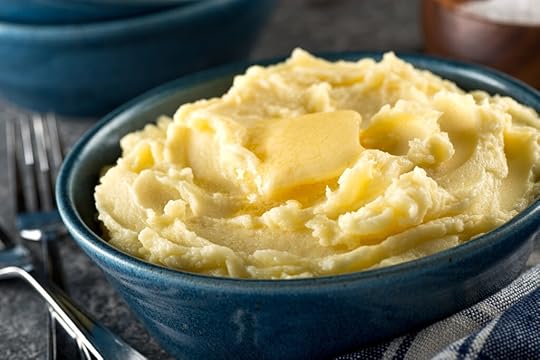
The next round of my Thanksgiving Dinner Firehouse Challenge put real mashed potatoes vs. instant mashed potatoes. I understand the lure of instant mashed potatoes. You want comfort and you want it now. I love them so much that if food could be your spirit animal, mine would be mashed potatoes.
According to Wisegeek.com, a Canadian scientist developed instant mashed back in 1962. Nutritionally speaking, instant mashed potatoes offer roughly the same vitamins and minerals as the real mashed potatoes with the exception of Vitamin C.
To please palates, they tend to be higher in sodium, significantly higher than the amount of salt home cooks would add when making them at home from scratch. Like most brands, the instant mashed potatoes I used were based on Idaho potatoes. Here’s how the real thing stacked up to the packaged variety in our challenge.
In this challenge, I used my own recipe for Perfect Mashed Potatoes, based on the recipe I learned at Le Cordon Bleu in Paris. The key to that recipe is using a food mill (one of my favorite kitchen gadgets), although you can certainly use a masher.
The lowdown on homemade mashed potatoes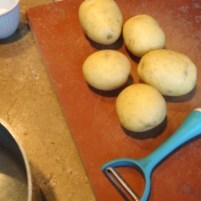 At $3.99 for a five pound bag of Yukon Gold potatoes and 75 cents in butter and milk, homemade wins in the cost department. The standard serving size for mashed potatoes used by caterers is about 2/3 cup mashed potatoes per person.
At $3.99 for a five pound bag of Yukon Gold potatoes and 75 cents in butter and milk, homemade wins in the cost department. The standard serving size for mashed potatoes used by caterers is about 2/3 cup mashed potatoes per person.
However, packages for instant mashed potato list 1/2 cup as a serving, so I used that as a standard although one of my brothers would look at me as if I was punishing him if I served up only half a cup.
A pound of potatoes yields about two cups mashed or four servings. So, five pounds of potatoes yields 20 servings. Although they are not challenging, homemade mashed potatoes do take time. There’s peeling and mashing, plus you need a large pot, a strainer and at least a fork.
Process: Peel the potatoes, boil, mash with butter, milk, salt and pepper. (See my full recipe on making perfect mashed potatoes the French way.)
Active time: 18 minutes (peeling, mashing)
Total time: 38 minutes
Cost per serving: 23 cents
Ingredients: POTATOES, BUTTER, MILK, SALT, PEPPER
 In the bag, you get four ounces of powdered mashed potatoes flakes imbued with the other stuff listed below. The Idahoan package reads “with Buttery Homestyle flavored mashed potatoes, you’ll enjoy the superior taste of Idaho potatoes blended perfectly with real butter. They’re satisfyingly rich. They’re delightfully creamy. And the genuine buttery flavor is 100% irresistible.”
In the bag, you get four ounces of powdered mashed potatoes flakes imbued with the other stuff listed below. The Idahoan package reads “with Buttery Homestyle flavored mashed potatoes, you’ll enjoy the superior taste of Idaho potatoes blended perfectly with real butter. They’re satisfyingly rich. They’re delightfully creamy. And the genuine buttery flavor is 100% irresistible.”
However, there is no actual butter listed in the ingredients, only a “butter powder” that includes sweet cream, salt and annatto coloring. But since butter is made from cream originally, this may be viewed as splitting hairs. An issue here is about the reliability of the serving size quoted. In the supermarket, I asked a woman buying this product how many servings a packet usually yields and she said two. “My husband and I usually split one.” She was buying six packets for Thanksgiving to feed seven guests. Each 1/2 cup serving contained a hearty 19% of daily sodium intake, so if you’re actually eating two servings, that 40% of your daily sodium in one cup of food. It is worth that after potatoes, the second ingredient is partially hydrogenated oil, a common additive used to extend shelf life that has can lead to elevated LDL cholesterol levels. (That’s the bad cholesterol.)
Process: Add pouch contents to boiling water. Remove from heat, let stand one minute. Fluff with fork.
Active time: 2 minutes
Total time: 4 minutes
Total Cost: $1.39 per packet
Cost per serving: 35 cents
Ingredients: IDAHO® POTATO SLICES (PRESERVED WITH SODIUM BISULFITE), PARTIALLY HYDROGENATED OIL* (CONTAINS ONE OR MORE OF THE FOLLOWING: SOYBEAN, COTTONSEED, SUNFLOWER), CORN SYRUP SOLIDS, SALT, MALTODEXTRIN, COCONUT OIL, NONFAT DRY MILK, SUGAR, WHEY POWDER, SODIUM CASEINATE, BUTTER POWDER (BUTTER: SWEET CREAM, SALT ANNATTO COLOR), NONFAT MILK SOLIDS, SODIUM CASEINATE AND DISODIUM PHOSPHATE, MONO & DIGLYCERIDES, CALCIUM STREARYL LACTYLATE, NATURAL AND ARTIFICIAL FLAVORS, SPICE, SODIUM ACID PYROPHOSPHATE (TO MAINTAIN FRESHNESS), SODIUM BISULFITE (TO MAINTAIN FRESHNESS), DIPOTASSIUM PHOSPHATE, LECITHIN, ARTIFICIAL COLOR, CITRIC ACID (TO MAINTAIN FRESHNESS), MIXED TOCOPHEROLS (VITAMIN E) (TO MAINTAIN FRESHNESS) AND LESS THAN 2% SILICON DIOXIDE ADDED AS AN ANTI-CAKING AGENT.
Homemade mashed potatoes: 7
Instant mashed potatoes: 0
In my taste test with a group of firefighters, all seven not only favored the real mashed potatoes over the packaged variety, they picked them out right away. Among their comments:
“The real mashed have a butter flavor. The instant ones taste like the butter salt on popcorn.” “The instant ones tasted like the kind that come in a TV dinner.”“The [instant potatoes] are really white, like they’ve been bleached.”“Compared to the real potatoes, [the instant ones] taste sort of flat and salty.”“I have to admit, I’m used to [the instant potatoes] since I eat a lot of frozen dinners. But the real ones are way better.”“The homemade potatoes have a rich, smooth texture. I could eat a ton of these.”Conclusion: When it comes to real mashed potatoes vs. instant, people can tell the difference and often right away. Try this challenge yourself and you’ll find that side-by-side, they really don’t taste the same. If you’re going to try to pass them off in place of the real thing, your guests will know. I noticed that most of the firefighters ate all of the real mashed potatoes but had only a couple of bites of the instant version. Given these results and the high number of artificial ingredients, some of them with negative health implications, the time tradeoff is generally not worth it.
Update: Packaged Mashed PotatoesAfter reader feedback, I decided to do a taste test on prepared mashed potatoes sold in supermarkets. Rather than the firefighters, due to the pandemic, I tried them on my family. Hardly a scientific sampling but given our varying Irish heritages, we are people who love and adore mashed potatoes at a genetic level. I prepared a pot of my own recipe for Perfect Mashed Potatoes to compare against Simply Potatoes Classic Mashed Potatoes. I chose this brand as it had the fewest artificial ingredients and the lowest sodium.
Process: Reheat by microwave or on the stove top.
Active time: 5 to 10 minutes
Total time: 5 minutes
Total Cost: $4.49 for 24 oz.
Cost per serving: 89 cents (1/2 cup); or $1.12 (2/3 cup)
Ingredients: POTATOES, DEXTROSE, CONTAINS 1/2% OR LESS OF FOLLOWING: DISODIUM PYROPHOSPHATE (ADDED TO MAINTAIN COLOR), POTASSIUM SORBATE AND SODIUM BISULFITE (ADDED TO MAINTAIN FRESHNESS)
Homemade mashed potatoes: 4
Packaged mashed potatoes: 0 – BUT a thumbs up with a few additions
Prepared mashed potatoes are a definite time saver. No boiling, no mashing, just heat and serve. In a disclosure moment, I confess that I sometimes buy them when short on time. Side by side with homemade, however, we agreed, that they lacked the rich flavor of real mashed potatoes and had a slightly metallic salt flavor.
HOWEVER…I took the same potatoes, heated them on the stove and added 1 tablespoon butter and a 1/4 cup of cream and a couple grinds of fresh ground pepper. This improved the flavor dramatically and seemed to offset the salt issue. While we could still pick out the homemade version, everyone finished their testing bowl.
Conclusion: If you’re going to go with prepared potatoes, I recommend looking for a brand with few ingredients and then heighten the flavor with a bit of added cream, butter and if desired, pepper and maybe even a bit of garlic powder. If you’re looking for a shortcut for a holiday dinner, this is a much better option than instant. With a bit of added richness, this is definitely a shortcut that could go undetected by guests.
Be sure to check out my complete Thanksgiving guide for more tips and recipes.
1 2 3 4 5 6 7 -> NEXT: StuffingThis is part of a story based on a taste test with seven Florida firefighters in 2013. This page has been updated. Main mashed photo by Foodio, the rest by Kathleen Flinn. This post may contain affiliate links.
The post Real Mashed Potatoes vs. Instant appeared first on Kathleen Flinn.
November 25, 2022
19 Ideas for Holiday Leftovers
 Kentucky Hot Browns: a masterful use of holiday leftovers
Kentucky Hot Browns: a masterful use of holiday leftoversLet’s be honest: We all tend to buy and make too much food for Thanksgiving. I do it every year. And you must have too, or you wouldn’t be looking for ideas for holiday leftovers, right?
Personally, I love holiday leftovers. They may even be the best part of the whole holiday dinner. When I go shopping for the main meal, I think ahead to what I’ll do with the leftovers. Will ham be on the table? I’ll pick up split peas or beans. Turkey or ham? I plan on making stock or soup from the bones.
A few years ago, I quizzed food writer friends about what they did with their holiday leftovers. Here’s some advice from them, along with some fresh ideas.
 1. Update the traditional leftover sandwich
1. Update the traditional leftover sandwich“I just recently created some holiday recipes for a grocery store and some of them used leftover turkey,” Amy says. “One of my absolute favorite recipes was a turkey, jack cheese and cranberry sauce melt on whole wheat bread.” A great example: her grilled cheese, pear and turkey sandwich.
“Turkey is really good in all kinds of grilled cheese sandwiches, so get as creative as you like with it,” Sherman says. ” Try it with chutney, slices of apple, tomato, roasted red pepper or a layer of leftover cooked vegetables like sautéed spinach or creamed onions. You could even use turkey or ham in a Reuben (in place of pastrami) or Cuban sandwich (in place of the roast pork). I like cheddar, jack or swiss cheese paired with turkey. Grilled cheese turkey sandwiches are so easy to make even kids can make them. Best of all they let you enjoy some of the flavors of Thanksgiving in a fresh way.”
 2. Make a Drink with the Cranberry Sauce
2. Make a Drink with the Cranberry SauceSeriously. For an elegant post-holiday toast, make a simple cranberry champagne cocktail by putting a teaspoon into the bottom of a flute and top with sparkling wine. Alternately, you can try my recipe for a “Crantini” for a post-shopping break. Combine 1 1/2 oz. gin, 1/2 oz. Cointreau, 1 teaspoon cranberry sauce in a shaker with ice. Shake vigorously and pour into chilled martini glass. Garnish with lime wedge.
3. Mashed potato pattiesOlga Massov has a terrific idea for leftover veggies. “One of my favorite things to do is to take leftover mashed potatoes and make these mashed potato patties with them and whatever leftover vegetables I have. Usually it’s caramelized onions and/or squash so I just combine them (cut the squash into smaller pieces if need be), bind with an egg, and fry in olive oil. I mix a lemon-dill yogurt dipping sauce and voila – vegetables reborn. It makes for a really delicious post Thanksgiving lunch!”
4. Kentucky Hot BrownsMy brother’s family has lived in Louisville for more than a decade. When my niece was married at the famed Brown Hotel, the meal options for the reception included a Kentucky Hot Brown. Looking around the room, it appeared 95% of the guests were tucking into one. A Hot Brown is basically an option faced sandwich topped with turkey, thin slices of tomato and a creamy cheese sauce. This is broiled until it’s slightly browned and bubbly and then topped with slices of bacon. I often skip the bacon and top the tomato with diced ham (if it was part of the meal) and then broil it. In place of the tomato, I’ve used leftover green beans or Brussel sprouts with great results. Try the original recipe from The Brown Hotel.
 5. Make Stock
5. Make Stock“I always make stock,” says Sheri Wetherall, the editor-in-chief of Foodista.com. “I roast the carcass with carrots, onions, celery and whatever yummy root veggies I have on hand until the bones are dark and golden, then simmer it for a long time on as low as I can get it until I have a luscious broth! I freeze it in small-sized batches for soups throughout the year. Check out my latest take on bone broth/stock for tips on how to extract the most goodness from those bones. Works for beef, turkey or chicken bones.
 6. Make Soup
6. Make SoupWhen you’ve got the stock, you can make a wide range of soups. You can keep the flavor of the holiday meal or really change it up. Check out my Soup 101 guide for how to make soup out of virtually anything, including bean soup from a ham bone. Meanwhile, here a couple of my favorite options from food writer friends:
Comforting Turkey Potato Soup from the WhiteOnRiceCouple.comTurkey Soup with Lemon and Barley from SimplyRecipes.com 7. Turkey Gumbo
7. Turkey GumboJaden Hair of Steamy Kitchen is a fan what I typically do with a leftover turkey: make turkey gumbo. “What’s great about this is that it’s nearly a one-pot meal, easy to make and has such intense flavor that’s DIFFERENT from night-before menu,” Jaden says. I totally agree. See my guide on how to make gumbo out of (almost) anything.
8. Turkey and DumplingsKeep the comfort food going. Wetherall has a great twist on the classic chicken and dumplings on Foodista.com.
9. Make Meaty SaladA twist on chicken salad, a simple turkey salad can be an easy lunch when plopped onto a bed of simple greens or put inside a pita. I like this recipe from Kalyn’s Kitchen. Made roast beef? Make a simple green salad, top with blue cheese dressing and slices of roast beef.
 10. Turkey or Beef Pot Pie
10. Turkey or Beef Pot PieA classic. I liked this updated version with cheddar biscuits as the top crust from Just a Taste.
11. Sweet Potato SouffleIf you end up with a lot of mashed sweet potatoes like we seem to every year, consider trying your hand at shifting them into a souffle. Note: this won’t work if you covered up their naturally sweet flavor with tons of syrup or marshmallows. Marla Meredith at FamilyFreshCooking.com has a lovely recipe for sweet potato souffles with feta and sage.
 12. Fry the Leftover Sage Leaves
12. Fry the Leftover Sage LeavesI did this a couple of years ago. It genuinely intensifies the flavor and adds a certain something to a leftover sandwich or even crumbled into a dish. Saveur’s recipe is the best one I’ve found.
 13. Try Turkey Curry
13. Try Turkey CurryRemember the opening of Bridget Jones Diary? Every New Year’s Day, Bridget’s mother hosted her turkey curry buffet. I found it hard to get a turkey in November. Why? They don’t celebrate Thanksgiving and turkey tends to be reserved for Christmas dinner. Curry is a very traditional means to dispatch the leftovers from the holiday turkey. I’ve used this recipe from the BBC site for the past couple of years. When it calls for “double cream,” you just use whipping cream. I’ve used sweet potatoes in place of the butternut squash.
 14. Make croutons
14. Make croutonsIt seems like there’s always leftover rolls and bread from holiday meals. You can only eat so many sandwiches or consume so many carbs. Don’t throw it away. Dice it up, toast it and make it into croutons.
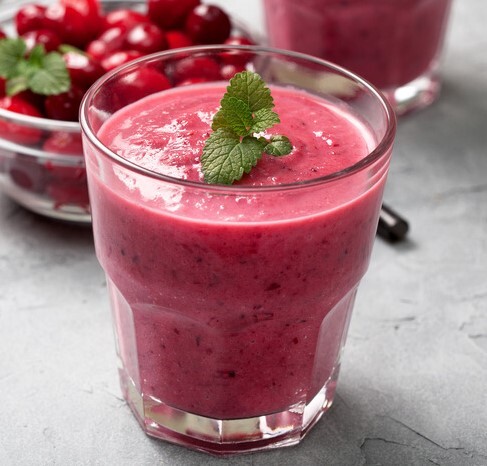 15. Orange Cranberry Smoothies
15. Orange Cranberry SmoothiesEven a couple tablespoons of cranberry sauce can transform a simple smoothie. In a blender, combine a few tablespoons of leftover cranberry sauce, ¼ cup orange juice, ½ cup yogurt, a banana, a bit of honey and blend together. Taste and add a bit more honey if needed.
16. BLT Turkey Tacos with Cranberry SalsaI tried this recipe from How Sweet Eats a couple of years ago. I admit that I use tortillas something of a crutch to use up leftovers. This felt like a great complement to the carb heavy holiday meal with a few crumbles of bacon tossed in to complement the sweetness of the cranberry salsa.
17. Turkey PanzanellaBy definition, the famed Italian summer lunch dish, panzanella, is itself a leftover dish. In this classic Tuscan dish, chunks of stale white bread are tossed with sliced onions, chopped tomatoes and basil then soaked with a vinaigrette made with good olive. Take the leftover rolls and bread from the dinner and toast lighter if not sufficiently stale, make a lemony vinaigrette and toss in chopped turkey, tomatoes and herbs.
 Use up leftover turkey and ham in a composed salad, such as a Cobb18. Turkey or Ham Cobb Salad
Use up leftover turkey and ham in a composed salad, such as a Cobb18. Turkey or Ham Cobb SaladIf you’re ready to go low carb after the big dinner, a cobb salad is just the ticket. Grab a couple avocados, tomatoes and some bleu cheese when you’re shopping for the rest of the meal. After that, all you have to do is boil a couple of eggs. Take leftover turkey and ham (or bacon) and voila!
19. Meatballs from Leftover StuffingFinely chop turkey and mix leftover stuffing with an egg and leftover stuffing and Italian seasoning and bake for about 10 minutes. Put on a roll with some cheese for a lovely meatball sandwich. If you want more traditional meatballs with beef (or a plant-based ground protein), check out this recipe from Good Housekeeping.
Originally published in 2014. Updated November 2020.
The post 19 Ideas for Holiday Leftovers appeared first on Kathleen Flinn.
November 24, 2022
How to Make Healthy Ramen

It’s hard to beat the guilty pleasure of instant ramen. It’s inexpensive and endlessly versatile, but as sold it’s just empty carbs and a ton of sodium. So how to make ramen healthier? Here’s my strategy.
For those purists who will balk at this version and say, “Hey, that’s not authentic!” Yes, I know. I’ve had the real thing in Japan, too, where ramen masters can elevate it to a culinary art form. If you want to make more authentic-style ramen, I suggest checking out the book Let’s Make Ramen. It’s both functional and fun, and offers step-by-step instructions in comic book form. This is for those home cooks looking for an updated, healthier version of the beloved cheap ramen packets.
Consider Upgrading Your NoodlesThere’s absolutely nothing wrong with those super cheap packets of noodles. But, I prefer to buy Hime Ramen Noodles on their own as the flavor is better. You can get 16 bundles of noodles for about $12 from Amazon and for even less at an Asian market if there’s one near you. The texture and flavor is better, and while it’s not 25 cents, it’s still a great value as one bundle makes two legit servings while the packets say they offer two servings, but in reality, it’s one.
Toss That Flavor PacketThe first step to make ramen healthier? Throw out the flavor packet, which is little more than an artificially flavored salt lick. Instead, I use miso to flavor the broth. You can find a tub of white miso in many supermarkets these days, either in the international food aisle or near tofu in the fresh aisles of a produce section. It’s the least expensive at Asian food-focused stores if there’s one nearby, or you can buy on Amazon. Once you have miso on hand, try adding it to soups, spaghetti sauce and salad dressings for an extra kick of umami. I love miso so much that I even wrote a recipe for miso chicken for the Japanese Ministry of Agriculture. Packaged instant miso soup works well, too, and you can find it most grocery stores, including Trader Joe’s.
If miso isn’t your thing or you can’t get your hands on some, you can also use vegetable broth, chicken or beef stock. In a pinch, you can use your choice of Better Than Bouillion.
About the proteinPork is the go-to protein for ramen in Japan. I’ve made this recipe for Japanese-style pork butt for years. However, after having chicken ramen at Wagamama in London, tofu ramen at a Japanese restaurant in Seattle and shrimp ramen in Tokyo, I can assure you that pretty much any kind of protein will work. I’ve even used leftover shredded dark turkey meat from Thanksgiving, leftover chicken from Coq au vin and leftover Texas-style beef brisket.
If you start with a protein, cook it first. For chicken breast, I recommend leaving it whole and toss with the lime or lemon juice, salt and pepper and quickly sear in canola oil for about three minutes per side until cooked through. Slice, and place on top of finished ramen soup. Or, just crack and egg into it and let the heat cook it through. (Don’t use sesame oil for searing; it is too delicate and will smoke up your whole house.)
If you’ve got leftover roasted chicken or precooked shrimp from another recipe, just add it in at the end and warm through.
Customize itTo make ramen healthier is to add to it. Like so many soup recipes, this is just a starting point. I like to include a bit of chopped leafy greens, green onions leftover veggies and siracha. If have it, add slices of ginger or onion. I might add a bit of wasabi powder into this mix. Leftover steamed bok choy, cooked cabbage, roasted carrots, sliced raw onions, thawed frozen spinach, dried seaweed, all are great additions and part of what makes ramen such a great vehicle for leftovers. Just think about what might taste good together and start from there.
Notes from recipe testers: “To experiment with new flavors, add a little at a time to preference. Taste the separate ingredients (such as miso paste) to get an idea of how much to start with or how it will affect flavor. My miso paste seemed pretty salty so I didn’t start with any salt and then checked for taste later in the process.”
“I make the broth first to get the flavor I want, then add in the noodles. I’ve added in all kinds of leftover vegetables, from green beans to Brussel sprouts. Just be sure whatever you add in isn’t seasoned with something that will conflict with the flavor you’re going for.”
Also: “Usually when I add raw egg to the ramen broth, I stir it in just before I take it off the heat so we have more of an egg-drop thing. Makes it easier to divide the soup up than deciding who gets the poached egg.”
This post contains affiliate links. It was first published in 2013. It has been updated.
 PrintRamen Revisited – A Flexible Recipe for Healthier ResultsA strategy to use the classic comfort of ramen noodles to make an inexpensive, vegetable-laden dish with much lower sodium. A key to this strategy is to toss the soup packet that comes with inexpensive packs of ramen noodles as its mostly sodium and chemicals. I prefer to buy Hime Ramen Noodles on their own as the flavor is better. You can get 16 bundles of noodles for about $12 from Amazon and for even less at an Asian market if there's one near you. Course PastaCuisine JapaneseKeyword budget friendly, Easy, fast, ramen, soup, vegetarianIngredientsFor the protein1 lime or small lemon4 oz. shrimp, tofu, sliced beef or chicken breast1/8 tsp coarse saltSeveral cranks of fresh pepper1/4 teaspoon red pepper flakes2 tablespoons vegetable or olive oilFor the broth1 package ramen noodles1 tablespoon miso paste or 1 packet instant miso soup2 teaspoons soy sauceTwo or three green onions chopped (optional)2 tablespoons chopped parsley, cilantro, kale or spinachOptional garnishes1 egg1/2 can bamboo shoots or 1/4 cup fresh sprouts optional1/2 to 1 cup cooked vegetablesHot chili sauce such as sirachaSesame oilInstructionsCut the lime or lemon in half. Juice one half into a bowl large enough to hold your shrimp, tofu, beef or chicken. Cut the other into small pieces and set aside. Toss with the salt, pepper and about half the oil and let rest for a few minutes. Add the rest of the oil to a small saute pan or skillet over medium-high heat and saute the shrimp or chicken until cooked through.Bring 3 cups of water to boil. Add the noodles and cook as directed by the package. If using a raw egg, carefully crack it into a corner of the pan and poach it in the water as noodles cook. Remove from heat and add the miso paste or soup mix plus the soy sauce and let steep for a couple of minutes.Portion the soup into two bowls. Add the green onions and herbs, plus any vegetables, bamboo shoots and stir through. Top with the egg and shrimp, tofu and the reserved lemon or lime pieces. Add Sriracha, soy sauce and/or sesame oil to taste if that’s your thing.
PrintRamen Revisited – A Flexible Recipe for Healthier ResultsA strategy to use the classic comfort of ramen noodles to make an inexpensive, vegetable-laden dish with much lower sodium. A key to this strategy is to toss the soup packet that comes with inexpensive packs of ramen noodles as its mostly sodium and chemicals. I prefer to buy Hime Ramen Noodles on their own as the flavor is better. You can get 16 bundles of noodles for about $12 from Amazon and for even less at an Asian market if there's one near you. Course PastaCuisine JapaneseKeyword budget friendly, Easy, fast, ramen, soup, vegetarianIngredientsFor the protein1 lime or small lemon4 oz. shrimp, tofu, sliced beef or chicken breast1/8 tsp coarse saltSeveral cranks of fresh pepper1/4 teaspoon red pepper flakes2 tablespoons vegetable or olive oilFor the broth1 package ramen noodles1 tablespoon miso paste or 1 packet instant miso soup2 teaspoons soy sauceTwo or three green onions chopped (optional)2 tablespoons chopped parsley, cilantro, kale or spinachOptional garnishes1 egg1/2 can bamboo shoots or 1/4 cup fresh sprouts optional1/2 to 1 cup cooked vegetablesHot chili sauce such as sirachaSesame oilInstructionsCut the lime or lemon in half. Juice one half into a bowl large enough to hold your shrimp, tofu, beef or chicken. Cut the other into small pieces and set aside. Toss with the salt, pepper and about half the oil and let rest for a few minutes. Add the rest of the oil to a small saute pan or skillet over medium-high heat and saute the shrimp or chicken until cooked through.Bring 3 cups of water to boil. Add the noodles and cook as directed by the package. If using a raw egg, carefully crack it into a corner of the pan and poach it in the water as noodles cook. Remove from heat and add the miso paste or soup mix plus the soy sauce and let steep for a couple of minutes.Portion the soup into two bowls. Add the green onions and herbs, plus any vegetables, bamboo shoots and stir through. Top with the egg and shrimp, tofu and the reserved lemon or lime pieces. Add Sriracha, soy sauce and/or sesame oil to taste if that’s your thing.The post How to Make Healthy Ramen appeared first on Kathleen Flinn.
November 9, 2022
The Firehouse Challenge: Packaged vs. Homemade Thanksgiving Dinner Classics
 For years, my father-in-law’s second wife served boxed stuffing at her holiday gatherings, spiced up with cut-up precooked turkey sausage. When I offered to make some homemade stuffing one year, she waved me off. “No one can the tell the difference, anyway.” But I can tell, I thought. Am I alone?
For years, my father-in-law’s second wife served boxed stuffing at her holiday gatherings, spiced up with cut-up precooked turkey sausage. When I offered to make some homemade stuffing one year, she waved me off. “No one can the tell the difference, anyway.” But I can tell, I thought. Am I alone?
This made me wonder. How do real mashed potatoes, gravy, fresh green beans and cranberry sauce stack up to their processed cousins? What about a frozen supermarket turkey versus a fresh, organic bird?
There’s only one way to find out.
I made two dinners with classic holiday side dishes — mashed potatoes, gravy, stuffing, green beans and cranberry sauce. The catch: one featured all homemade sides, and the other were made from a box, can or jar.
I needed objective judges. Fortunately, there’s a group of pros more than up for the task: the guys on Shift A at the Station 1 in Holmes Beach, Florida.
The next few pages break down each of the dinner components by hassle factor, price, time and specific flavor comments from the firefighters. You’ll find links to most of the recipes, too.
1 2 3 4 5 6 7 -> NEXT: Supermarket turkey vs. OrganicNote: This post was originally published in November 2013. It was updated in November 2022
The post The Firehouse Challenge: Packaged vs. Homemade Thanksgiving Dinner Classics appeared first on Kathleen Flinn.
November 8, 2022
Thanksgiving Doesn’t Have to Be Hard
Every year I polish up my Thanksgiving guide with all the usual fare, from a primer on turkeys to what to do with leftovers. I’ve been pulling all of this together for the past 10 years, updating it each year with new recipes and tips, and this year is no different. If you have any thoughts or anything to add, let me know!
[Updated November 2022]
 Sick of Cooking? Get Thanksgiving in a Box
Sick of Cooking? Get Thanksgiving in a BoxOrder in from a local restaurant, try a meal kit or a pre-cooked sides or the whole thing.
 27 Holiday Dinner Tips from the Pros
27 Holiday Dinner Tips from the ProsFood writer friends weigh in on planning and executing a Thanksgiving meal. I asked what strategies they’ve learned and pulled them together for a guide every cook can use.
 Frequently Asked Questions: Turkey
Frequently Asked Questions: TurkeyA one-page guide to common questions featuring brief, sensible answers. From what type of bird to buy to how to cook it and carve it. I even tackle whether you can cook a frozen turkey.
 What to Buy? What to Make? How Much Per Person?
What to Buy? What to Make? How Much Per Person?Just assembling all the stuff for a big holiday dinner can be confusing. How much to buy per person? What can you buy guilt-free?
 How to Put Together a Holiday Menu
How to Put Together a Holiday MenuSure, it seems obvious. But if you’ve never done it, or you feel like you’re always overdoing it, take these tips from top food writers.
 Processed vs Homemade
Processed vs HomemadeI challenged a group of firefighters to tell the difference between a holiday meal made with an organic turkey and homemade sides and another with a frozen bird and sides from boxes, cans and jars. The result? Take a look.
 19 Great Ideas for Leftovers
19 Great Ideas for LeftoversLeftovers are just as much of a holiday tradition as turkey and cranberry sauce. I’ve pulled some creative ways to make the most of them.
Foolproof Recipes Easy as Pie
Easy as PiePie maven Kate McDermott from Art of the Pie on the perfect pie crust, plus why no one should feel guilty using canned pumpkin.
 Perfect Mashed Potatoes
Perfect Mashed PotatoesFluffy, not lumpy, my Le Cordon Bleu-inspired recipe with a video by Chef John of FoodWishes.com
 Cranberry Relish with Orange and Port
Cranberry Relish with Orange and PortIf you can open a can of cranberries, you can make my family’s recipe for this classic from scratch. Promise.
 Potato Gratin with Chevre and Pancetta
Potato Gratin with Chevre and PancettaA different take on potatoes from food writer Jess Thompson that can be made in advance and heated up just before the big dinner.
 Carrots roasted with Mustard
Carrots roasted with MustardSurprisingly simple, strikingly tasty. Another winner from Jess Thompson’s book, Cooking Up Washington
 Bread Stuffing with Apples, Bacon and Caramelized Onions
Bread Stuffing with Apples, Bacon and Caramelized OnionsA simple, classic recipe from the celebrated food writer Diane Morgan. Cook the onions and bacon a day in advance, toss ingredients together and bake.
 Carrot and Rosemary Soup
Carrot and Rosemary SoupAn inexpensive, easy way to put the flavor of autumn in a bowl. Another make-ahead recipe with a complex taste but simple steps.
Finishing Butter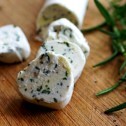 Adding a pat of flavored butter to simply prepared vegetables is perhaps the easiest side dish of them all. Learn just how easy it is to assemble.
Adding a pat of flavored butter to simply prepared vegetables is perhaps the easiest side dish of them all. Learn just how easy it is to assemble.
Some of the pages in this guide include affiliate links. Questions? Email me.
The post Thanksgiving Doesn’t Have to Be Hard appeared first on Kathleen Flinn.
November 6, 2022
Kat’s Thanksgiving Turkey FAQ
 That’s me, age four, stuffing a Thanksgiving turkey. I’ve been doing this holiday dinner thing a long time. So much information exists on the humble turkey, a curiously popular bird. Here are simple answers to common questions from reliable sources. Please note this page includes affiliate links. Have a question? Let me know. – Updated November 2022
That’s me, age four, stuffing a Thanksgiving turkey. I’ve been doing this holiday dinner thing a long time. So much information exists on the humble turkey, a curiously popular bird. Here are simple answers to common questions from reliable sources. Please note this page includes affiliate links. Have a question? Let me know. – Updated November 2022
A. Great question. As this terrific column in Slate explains, back in the day when people grew their own meats, large poultry presented the most expendable option to feed a crowd.
Q. What kind of turkey should I buy?A. Normally, I suggest buying fresh, if possible. Fine Cooking explains the variations on supermarket options, while Epicurious offers their findings on a taste test of common brands of Thanksgiving turkey. Want local? See EatWild.com’s guide to locally grown turkeys in the U.S. and Canada. Despite all the talk of heritage turkeys, they account for less than 1 percent of the turkey market, as noted in this illustrated account from Bountiful Cupboard.
I’ve cooked all the options, and I’ve found a thoughtfully grown free range turkey does taste better than the standard supermarket varieties. (We usually get a 16 lb. to 20 lb. turkey and it’s about $20 more.) I prefer fresh over frozen as I think the texture of the meat is better after cooking. I’ve splurged on local heritage turkeys, and my family thought they tasted too gamey. I’ve bought kosher birds, but they’re hit and miss. So if you can, buy a free range, organically fed turkey if your budget can afford it.
One note for 2022, though: If you’re set on turkey, you might want to buy yours earlier than usual or pre-order to reserve one via a supermarket, a restaurant or a local butcher. Due to an outbreak of avian flu, there’s a shortage of turkeys this year, and while unlikely, it’s possible they may become scarce in grocery stores if you wait until the last minute.
Q. How big a turkey do I need?A. It depends on whether you’ve got big eaters and/or big leftover lovers. Aim for roughly 1 pound per person for a reasonable amount of leftovers, and 1.5 pounds per person if you want heaps of extra meat.
Q. I have heard I shouldn’t stuff the cavity. Why is that?A. The Centers for Disease Control advise against this because the uneven cooking this employs can make people sick. Plus, it will take the turkey longer to cook. Just cook it in a separate casserole pan; you can never make enough in the cavity of the turkey for the whole crowd, anyway.
Q. How do I safely thaw a frozen turkey?A. Here’s a thorough guide form the USDA on the matter. Bottom line: either thaw a frozen turkey in your fridge, in a cold water bath or – very carefully – in a microwave. Just don’t set it on your counter and let it get to room temperature or you’ll greatly increase your odds of sickening your holiday dinner guests.
Q. Can I cook a completely frozen turkey?A. Yes. Simply plan for the roasting time to take about 50% longer than a thawed one. Put it into a 325F/162C oven for two hours. Remove from the oven and extract the giblets. Season as desired and continue to roast. By the way, many supermarket “heat and serve” meals come with a cooked turkey that’s frozen. Here’s how much time you’ll need to budget for, based on the USDA’s guidelines:
8-12 lbs turkey: 4-4 1/2 hours12-14 lbs turkey: 4 1/2-5 3/4 hours14-18 lbs turkey: 6-6 3/4 hours18-20 lbs turkey: 6 3/4-7 1/2 hours20-24 lbs turkey: 7 1/2- 7 3/4 hoursQ. Turkey, again? Really? Any alternatives?A. Personally, I’m a fan of duck or lobsters as a Thanksgiving turkey alternative. The editors of Food & Wine came up with a solid list of alternatives, including a stuffed flat-iron steak.
Q. Help! I have vegetarian or vegan guests coming. Can I serve them Tofurky?A. The Washington Post did a taste test on alternative faux meats for vegans, so check out those results if that’s your strategy. But I’m going to be honest and say the point of Thanksgiving isn’t about serving non meat eaters a highly processed bit of fake meat. I usually serve turkey and a vegetarian main. My go-to is this vegetarian pot pie recipe from Kim O’Donnell. If you’ve got more than one or two vegetarians at the table, consider making (or buying) a vegetarian gravy, such as this red wine mushroom version from Whole Foods Market.
Q. Do I need to brine the turkey, or can I skip it?A. You don’t have to wet brine. Indeed, Kim Severson of The New York Times wrote a bombshell story that essentially called it a fad that’s over. A wet brine involves putting the turkey into a solution laced with salt, herbs and usually some acid, such as cider or citrus. Alice Currah at Savory Sweet Life has a great example of how to wet brine a turkey.
Maybe it’s me, but I feel a wet brine makes turkey meat soggy. So, I’m partial to using a “dry” brine, which involved slathering the bird with a salt-based rub. The clearest and best example I can find of this is Russ Parsons version on Food52.
Q. Do I need special equipment?A. You need a pan with at least one-inch sides large enough to hold your Thanksgiving turkey comfortably without too much crowding. Handles are helpful, as is a rack. You can claim one for as little as $20 online. Avoid disposable, inexpensive aluminum roasting pans. No really. Don’t use them. They aren’t heavy enough to hold the weight of a turkey.
Let me paint you a scene: a cook pulls a golden turkey from the oven, and then the cheap pan crumbles, drenching her in boiling hot liquid as she tries to decide whether to catch th e hot carcass as it tumbles to the floor. This happened to someone I know. Don’t let it happen to you.
e hot carcass as it tumbles to the floor. This happened to someone I know. Don’t let it happen to you.
In a pinch, you can use the bottom of a broiler pan. No rack? No problem. Line the bottom of your roasting pan with carrots, celery, onion or potatoes to keep it from sticking. It will also make your gravy tastes great, too.
Q. What about basting?A. The jury’s out on whether basting moistens the meat, but it certainly doesn’t hurt anything and will add a lovely sheen to the final result. The easiest way to do it is with a bulb-style baster, but you can also use a silicon pastry brush, a small (new!) paintbrush or even a ladle. I always baste roast poultry.
Q. What’s the best way to roast a turkey in the oven?A. My friend Chef John at Foodwishes.com gives exactly the same instruction I would give you on cooking a turkey in his two-part video lesson. While I normally advise turning chickens over while roasting, most turkeys are too large to do this so skip that step during the holidays. For herb butter, go here.
Q. We want to deep-fry a turkey.A. Deep-frying a turkey is a popular and highly hazardous undertaking. Search “fried turkey disaster” and you’ll find hundreds of YouTube videos. A solid source for information comes from the blog Brian’s Belly.
Q. Can you grill a turkey?A. Grilling a turkey has overcome deep-frying as the fad du jour for the holiday bird. It does have two advantages. One, it frees up your oven for all the side dishes. Second, if you’ve got a grill master in the family, you can assign him or her the bird. Whoever takes on this task must absolutely first read Turkey Grilling Horror Stories. My favorite guide to barbecuing a turkey is from Sunset magazine, which featured a cartoon version of meat master Bruce Aidells in a simple how-to.
Q. What the heck is a turducken?An unholy concoction of a turkey stuffed with a whole duck and a chicken. Here’s where you can get one. The New York Times offers tips on how to cook it.
Q. How do I carve a turkey?A. I know the Norman Rockwell image involves bringing a whole turkey to the table. But this leads to performance anxiety. Solution? Call people to the table, bring the whole roasted turkey in for “viewing,” and then whisk it back to the kitchen and carve it while everyone gets seated.
Ditch the carving set. The best tools are a nice sharp chef’s knife and a pair of tongs. The Food Network’s Alton Brown offers a great primer. It’s exactly the way I carve a turkey.
Q. What is “spatchcocking?”A. An old English term for cutting out the backbone, also known as butterfly in North America it. This doubles the cooking area of the turkey so it can roast in two hours or so, depending on size. This isn’t difficult but it does require a sharp knife or poultry shears and some confidence. This is how I cook my Thanksgiving turkey so I don’t have to get up at 5 a.m. I butterfly it a couple nights before, pat it with a dry brine and leave it in the fridge. I roast the back bones and use them for stock to make gravy the day before Thanksgiving. My man Alton Brown shows how it’s done.
Q. How long can leftover turkey meat stay in the fridge?A. The USDA guidelines say a cooked turkey should only be stored in a refrigerator for three to four days with a temperature of 40°F or less. This means if you hold your Thanksgiving feast on Thursday, aim to use all turkey leftovers by Sunday evening. This includes using the carcass for stock. When you raid the fridge for leftovers, swiftly return the turkey meat back into the fridge as the bacteria that can cause food poisoning will start to grow at room temperature. Alas, refrigeration will reduce the speed, but it doesn’t stop the growth of bacteria. See their full guidelines on poultry here, and how to tell when it’s gone bad.
Q. Can I freeze leftover turkey?A. Yes, but you must freeze it within three to four days of cooking. Properly stored cooked turkey will last for up to four months. Be sure to tightly wrap the leftovers in two layers to avoid freeze burn and get my tips on freezing other leftovers so you can actually use them later.
More ThanksgivingHomemade Mashed Potatoes vs. Instant
Homemade Green Beans vs. Canned
Conventional Turkey vs. Organic
Originally published in 2014, this page has been updated every year, most recently in November 2022. This piece contains affiliate links.
The post Kat’s Thanksgiving Turkey FAQ appeared first on Kathleen Flinn.
November 4, 2022
27 Great Tips for Thanksgiving from Food Writers









Holiday meals can cause even confident cooks anxiety. I asked some of my food writer friends for their best advice and best tips for Thanksgiving. – Kathleen.
Tips for Thanksgiving Planning
1. Make Lists
“Make lots of lists,” advises Diane Morgan, the author of The New Thanksgiving Table and The Thanksgiving Table. “Make a grocery list and divide it among the different stores you will have to shop at – butcher shop, bakery, wine shop, supermarket.” Sheri Wetherall, editor in chief of Foodista.com, says not to beat yourself up for using some thoughtful prepackaged items. “Order rolls from your local bakery; buy pre-washed salad greens,” she says.
2. Write down your menu
Check out the CookFearless guide to Thanksgiving menu planning. Don’t overlook cheese as an option for dessert. “It seems like people forget the option for Thanksgiving,” says Judith Finlayson, the author of a dozen cookbooks, including 750 Best Appetizers. “My husband goes crazy on buying cheeses for a final course…served with port.
 3. Include “flexible” dishes
3. Include “flexible” dishes
Here’s food writer Jess Thomson’s big secret. “I always try to reduce the number of dishes I feel have to be piping hot. I think there’s a huge misconception that all the food has to be ready at exactly the same time. With that in mind, I always include dishes that are more flexible–roasted carrots, for example–and dishes that are really better after they sit for 15 or 20 minutes, like a potato gratin. ” (I have made her mustard carrot recipe the past two years.)
4. Don’t be afraid to serve the same menu from last year
Speaking of repeating her carrot recipes… “While food editors at magazines try to find ways to spice up the traditional favorites, the reality is that many people look forward to the classics. “I always make the same thing…no one will allow me to change it,” Finlayson says. “Turns out that’s great because I don’t need to spend any time thinking about what to make: turkey, giblet gravy, mashed potatoes, Brussels sprouts and my grandmother’s sage and onion stuffing.”
5. Develop a schedule
Write down a full schedule for cooking, setting the table, all the tasks you need to do, including fixing up the bathroom, advise Amanda Hesser and Merrill Stubbs, co-founders of Food52.com. “Start as early as you can, even a week ahead,” Hesser says. “You don’t want to have all of your cooking done before the big day, you want to have everything else done, so you can cook in a relaxed way and hang out with your family as you do so.”
 6. Get your knife or knives sharpened
6. Get your knife or knives sharpened
If you’ve got a good chef’s knife, take it in to get it sharpened ahead of the big meal. Some options: Most Sur La Table outlets, cutlery shops, good local hardware stores and even restaurant supply outlets. Don’t have a decent chef’s knife? Maybe it’s time for an early holiday gift for yourself. This is a good time to sharpen your knife skills.
7. Review your recipes a few days ahead of time
This tip comes from veteran cookbook author Cynthia Nims. Not only can you be assured you’ve got ingredients covered, but also “make sure techniques don’t trip you up,” she says.
8. Enli st help with the cooking
st help with the cooking
Who says you have to do all the cooking? “Just because the Pilgrims invited the Indians for the first harvest feast didn’t mean the Indians came empty-handed,” Morgan says. Make it a potluck Thanksgiving. Put together a menu and then call up guests to assign them a dish. Be sure to specify if they plan to bring it in a table-ready service piece or if they’re showing up with their sweet potato tart in Tupperware, so you’ll know whether to be prepared with a serving dish and utensils for their contribution. Don’t forget to get kids to help — that’s me in the photo left, at age five, helping to stuff a turkey.
9. Embrace a holiday dinner routine
Cookbook author Judith Finlayson’s strategy of enlisting help has developed into a holiday routine. “We have regular guests who do specific things every year. One couple makes gravlax for the starter. They bring it already-sliced on a platter, accompanying dill sauce in its small bowl ready to be unwrapped, pumpernickel rounds ready-to-go. We all expect it and look forward to its arrival and the uncorking of the champagne. Our regular family guests (six in total) bring dessert, and friends bring sides. It varies from year to year but we have our rhythms and it all works out. ”
10. Use Technology
If you use Evite, you can even jot down a menu and guests can claim what they want to cook. “Hey, you can even assign someone kitchen duty — just be sure you give them an extra beverage to sip while they’re elbow-deep in dishes,” Morgan suggests.
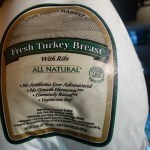 11. Allow enough time for the turkey to thaw
11. Allow enough time for the turkey to thaw
“If you are using a frozen turkey, allow at least five days for it to thaw slowly in the fridge,” says meat guru and cookbook author Bruce Aidells. “Better still, spend the money and buy a fresh heirloom turkey.” For more turkey tips, see the Turkey FAQ.
12. Set your table the night (or even two) days before.
Restaurants make sure all their tables are set for the next service. This includes making sure water pitchers are ready for filling, corkscrews are nearby for wine, water glasses are in place and so on. If you’re going to serve coffee, make sure you’ve got the coffee cups and set up the coffee ahead of dinner to be ready at dessert.
13. Don’t forget the kids table
Lay in some sparkling cider and add some fun factor to their table. TipJunkie has some great ideas that reach beyond your usual hand turkey drawings.
14. Pull out your table linens a few days in advance
Another good reason to set your table ahead of time is to be sure it’s all clean. “Splurge and have your table linens pressed by your dry cleaner!” Wetherall suggests.
15. Inventory your service and cookware
Set out your serving bowls, serving utensils and cookware as soon as you’ve figured out your menu.
This is particularly important if you’re new to entertaining. Write out your menu, then pull down the dish you plan to serve it in from what you’ll use to serve the turkey to whatever will hold butter for rolls, plus every single utensil you need. Put a post-it note on each item and leave them out if you can. In most cases, “missing” items can easily be borrowed. It’s better to know ahead of time than freaking at the last-minute that you forgot to think about a ladle for the gravy. Also, I can’t stress how valuable little tongs and pie servers are when hosting a big dinner.
Tips for Thanksgiving Kitchen Organization16. Mise en place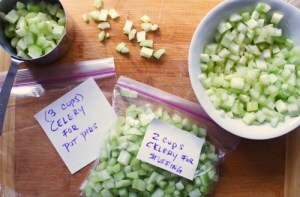
In French, this loosely translates to “everything in place,” and it’s a common chef’s strategy for kitchen efficiency. It means get as much prepped as possible before cooking. In my house, I do most of the peeling, chopping and measuring of ingredients a night or two prior to cooking; simply put chopped stuff into storage bins or bags and mark them as needed.
You can even measure out ingredients for each recipe ahead of time, right down to spices. (Tip: Use little Dixie cups.) Put them all together with a photocopy or printout of the recipe. The next day, it’s not only a simple assembly job, it’s also a great place to steer that relative who arrives midday and says, “Can I help?” Now they can, without bothering you every couple of minutes to ask where you keep various items.
Note: The one exception I make are potatoes for mashing. While you can store peeled potatoes in water overnight, they keep their color and taste better when freshly peeled.
17. Butter trick
Take sticks of butter and cut them into one tablespoon squares and set inside your fridge in a bowl. All the pros do this.
18. Use your grill
If temperature friendly outside, use your grill. It can act as an extra burner. Heck, you can even cook your turkey on the grill. Meat expert Aidells demonstrates how in this whimsical cartoon from Sunset magazine.
19. Out of counter space? Go vertical
Professional kitchens employ vertical racks known as “speed racks.” Depending on your kitchen, consider clearing out a cupboard hoarding cereals and pantry items and set it into a box in a bedroom so that you can use that area for extra space to set finished dishes, pies or collect all your mise en place while you’re cooking. (While you’re putting it back, go through the box and see what you’ve not used in the past six months and consider donating it to a food bank.
 20. Have a plan for the dirty dishes
20. Have a plan for the dirty dishes
If you’re using separate dishes for dessert, stack them near the table. Count silverware to assure you’ve got enough for each course, or set up a bowl with hot soapy water for a quick cleaning between courses. For years, I’ve employed a laundry basket or recycling bin as a bus tub. As dishes are gathered, they’re stacked in the tub along with non-fragile glassware, and set aside until ready for cleaning; the tub can even be set in another room or on the floor. They’re safe, out of the way and it eliminates the “immediacy” of having to race to clean up.
21. Countertop ovens can be a lifesaver
Wetherall of Foodista.com had to figure out a way to cook a turkey without an oven. “Three years ago our oven broke a couple of days before Thanksgiving and we couldn’t get a new one in time, so we had this retro-looking countertop roaster overnighted to us. I don’t think the company has changed the design since the 50s. I was very skeptical, but it cooked our turkey perfectly! The most delicious turkey we’ve ever made!” Until they moved into a new home a couple of years ago, the Foodista founders’ oven remains broken. “Indeed, it was like the cobbler’s children have no shoes.”
Tips for Thanksgiving Day Itself 22. Make punch
22. Make punch
“For big gatherings, I like to make punch with a twist,” said Monica Bhide, author of Modern Spice and the blog A Life of Spice. “That way people can help themselves and you are not tied to your bar doling out specialty cocktails to a large crowd.” Try the orange St. Germaine pitcher cocktails, left.
23. Know the turkey to take longer than you expect
“In my experience of cooking turkeys since I was 14, I learned this — the turkey always, ALWAYS, takes longer to cook than all the cookbooks say,” says Olga Massov, the founder of The Sassy Radish. “The best thing to do is buy one of those thermometers that can be inserted and monitored remotely so you don’t open the oven door and let heat escape, thereby losing precious cooking time and let the turkey get to 161 degrees. Then pull it out and let it sit for 30 minutes. Because it will continue to cook (and the temp will climb to the approved 165) while it sits… “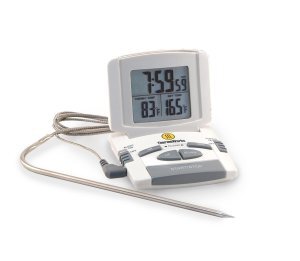
24. Hold food over steam, not just in the oven
One of the hardest things for home cooks putting on a big meal is getting everything to the table at the same time and while it’s all still warm. Most people hold things to keep them hot in the oven, but then that space becomes a premium if it’s still being employed and can overcook food. So, instead, think about those long steam tables at buffets and fill a few pans with water, heat it up, then place your serving bowl or pan in the hot water, cover it with a lid, foil or heat-resistant plastic wrap. Have more food than burners? I keep a couple of inexpensive individual burners on hand for just such occasions.
24. Put hot food on warm plates
“Hot delicious food deserves warm plates,” says Morgan. “You can warm your plates in a clean dishwasher set on the ‘dry’ cycle. Some dishwashers even have a plate warming feature or run the plates under very hot water, dry them and then wrap them in a terry towel until needed.”
 25. Be safe
25. Be safe
Ask everyone in your kitchen to wear shoes with closed toes while cooking. Unusual activity can cause chaos to occur in a kitchen, from hot gravy scalds to a knife falling unexpectedly and cause injury. Be sure you’ve got good oven mitts and keep them handy and dry as anything even moist can transmit heat and cause burns. Keep hand washing liquid and paper towels near the sink and be sure everyone washes hands frequently, not just after touching the turkey. Keep counters clear of debris and avoid stacking anything perilously on counters.
26. Take notes
After every Thanksgiving, Cheryl Sternman Rule heads straight to her computer while her husband does all the dishes. “So the first tip is to make your spouse/partner do all the dishes. That’s key.” But she’s doing something critical — making detailed notes about what dishes she made that year (with links to the recipes employed, what worked, and what didn’t immediately after her guests leave. If she modified a recipe, say added bourbon to the whipped cream for the pumpkin pie or used a special brine, she jots it all down.
“The idea is to realize that our memories aren’t always reliable when it comes to big annual occasions, and having these notes can save an enormous amount of time when planning for next year’s holiday. This is also a great place to jot down any food allergies or aversions that guests at your Thanksgiving table had so you’ll be prepared to make accommodations for those same folks next year.”
And the Most Important Tips for Thanksgiving?27. We can’t all be Martha or some Instagram Superstar. Cut yourself some slack
Remember, Julia Child suggested that you avoid apologizing for anything you felt went wrong in the kitchen. So you cooked the green beans too long, or your pie doesn’t look like the picture. So what? No one is going to tell you to pack your knives go home. Even food pros have had their share of kitchen disasters.
Food writer Cynthia Lair recounts a holiday 20-plus years ago in which she tried to mash stone-cold boiled potatoes. “Did you know that when boiled potatoes are cold, the mixer will suck the potatoes up into all the gears of the mixer until it shorts out? Well, neither did I.” The potatoes were beyond saving, as was the mixer. “But the salve here is that I have this embarrassing story to tell and laugh about! We don’t tend to remember the successes as clearly, do we?”
It’s Thanksgiving, and all you should do is give thanks for the good stuff in your life and pack up the rest with the leftovers.
[Originally published in 2014; updated November 2022]
The post 27 Great Tips for Thanksgiving from Food Writers appeared first on Kathleen Flinn.







